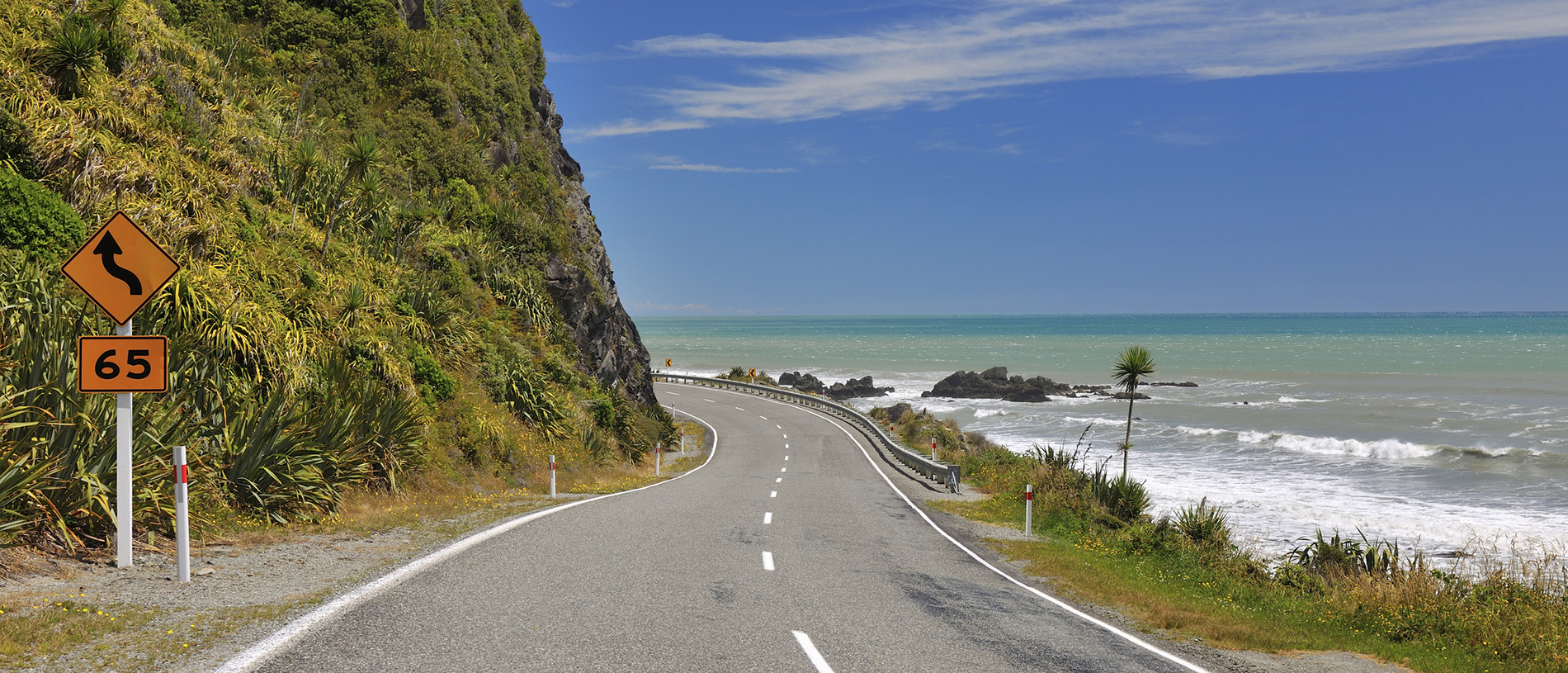
Great Coast Road: roadtripping at its best
Drive the length of the South Island, skirting the West Coast and traversing through the Southern Alps, and experience bountiful roadtripping at its very best.

We begin in high country station territory: Hunter Valley, Dingleburn, Lake Hāwea Station, each with thousands of hectares of pasture ideal for lean, leggy merino sheep.
Behind the farmland are mountains, bare of forest, showing their structure in patterns of jagged rocky escarpments and topped with snow, white and bright.
Along the east side of Lake Hāwea towards Dingleburn Station, the gravel road is skinny, rutted, occasionally edging around a cliff above the lake.
Where the Tīmaru River joins the lake, breaking into tendrils like a frayed rope, I paddle in the icy water and wonder what it would be like to live here, fitting in between lake, mountains and sky.
Nearby, a camp is being set up under a grove of trees. Blokes arrive in dusty utes with dogs on the back, for what looks like a female-free night around the campfire. That is what it must be like to live here: work done for the week, you camp out with your mates and tell yarns.
The drive along the west side of Lake Hāwea is glorious, with views of pasture, lake and mountains following each other almost as fast as the fence posts flick by. Highway 6 swings left at The Neck, a narrow, isthmus between Lakes Hāwea and Wānaka.
Within just one kilometre we are in a different world. Mountains here are topped with clouds. It’s cooler and there’s forest instead of farmland; mānuka and kānuka in flower instead of briar roses.
Makarora township, in a valley by the river of the same name, has a pub, an airstrip, a few deer farms and the Makarora Tourist Centre, where we stay in one of a dozen A-frame cottages.
No alarm clock is needed the next morning because the dawn chorus does the job nicely. The combination of tweeting, chiming and trilling from kererū, fantails, tomtits, tūī, bellbirds and imports such as finches and thrushes, ring in the quiet morning.
The road from Makarora, over Haast Pass and beyond to the coast is through virgin forest.
This 80km drive can, in theory, be done in just over an hour, but we take all day and visit every waterfall within walking distance. There are plenty, mostly metaphorically named: Fantail Falls, Thunder Creek and Roaring Billy. Waterfalls, nature’s never-ending show of sound, action and power, have their own individual magic and a bonus is the forest walks to see them.
Before the Pass, it’s mostly beech forest. Trees have black-mossed trunks and their branches are festooned with pale green lichen. Years of leaf litter cover the forest floor, a paradise for fungus and ferns. Up close, all elements make up a beautiful and intricate world of things growing.
The road from Haast township to Jackson Bay is straight, flat and sealed. The myriad of forest greens is interspersed with bursts of vivid red rātā flowers. In places, giant trees touch overhead while luscious ferns unfurl below.
At Arawhata River the bridge forms a viewing platform up the wide valley, the river curved to where wisps of cloud cling to snowy peaks. The clear turquoise water swirls into pools and rushes over boulders, rolling them smooth.
We’re told there’s greenstone in the gravel. Fossicking for stones in the morning sun, with the soothing river thrum is a pleasant pastime.
We leave the coast to follow a gravel road inland alongside a tributary, through podocarp forest: tōtara, rimu, southern rātā, mataī and miro. Like the beech forest, it has a layer lavishly decorated with fern, lichen and moss, but the canopy is taller, grander. It’s an easy stream-side walk to Lake Ellery where the forest is reflected in perfect stillness.
Jackson Bay, at the southern end of the West Coast Road, is sheltered from the predominant south and westerly winds. The safe anchorage is the reason the road reaches this far. The village consists of 12 houses, a long wharf, a crayfish chiller warehouse and, surprise, a café in a caravan. The Cray Pot, perched on the seafront, serves great kaimoana – blue cod, whitebait fritters, crayfish and more.
Locals fish off the wharf, dolphins play in the bay, a fishing boat arrives at the beach and bigger commercial boats sit calmly at buoys. We eat our lunch and watch it all.
From lakes, through ancient forests and mountain passes, past waterfalls and rushing blue rivers, to the sea – this journey pays homage to our land’s extraordinary geography and wild beauty. And endearing Jackson Bay is the small exclamation mark at the end of the road.